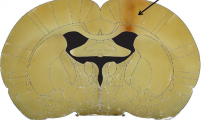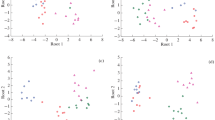Abstract
The effects of two-day water deprivation and hyperhydration (provision of 4% sucrose solution for 48 h) on levels of serotonin and its major metabolite 5-hydroxyindoleacetic acid (5-HIAA) in the midbrain and hypothalamus were studied in Wistar rats. The rates of diuresis (0.05 ± 0.01 and 0.84 ± 0.12 ml/h/100 g in water deprivation and hyperhydration respectively) and urine osmolality (1896 ± 182 and 50 ± 13 mOsm/kg) reflected increases and decreases in blood vasopressin levels. Water deprivation was associated with a significant increase in 5-HIAA levels in the midbrain and hypothalamus, along with a decrease in serotonin levels and a three-fold increase in serotonin catabolism (the 5-HIAA:serotonin concentration ratio). Hyperhydration induced moderate increases in serotonin and 5-HIAA levels in the hypothalamus with no changes in the midbrain. The blood corticosterone level doubled in water deprivation and decreased in hyperhydration. It is suggested that activation of the serotoninergic system induces a complex adaptive reaction in water deprivation, including mechanisms specific for the regulation of water-electrolyte homeostasis and non-specific stress mechanisms (vasopressin and corticoliberin secretion).
Similar content being viewed by others
REFERENCES
L. K. Velikanova, Osmoreceptors [in Russian], Nauka, Novosibirsk (1985).
A. G. Genetsinskii, Physiological Mechanisms of Water-Salt Equilibrium [in Russian], Academy of Sciences of the USSR Press, Moscow, Leningrad (1963).
L. N. Ivanova, “Regulation of water balance in the body,” in: The Physiology of Water-Salt Metabolism in the Kidney [in Russian], Nauka, St. Petersburg (1993), pp. 43–70.
L. N. Maslova, E. V. Chernigovskaya, M. A. Belen'kii, O. A. Danilova, E. V. Naumenko, and A. L. Polenov, “The effects of serotonin on hypothalamic structures involved in the regulation of the hypophyseal-adrenocortical system,” Fiziol. Zh. SSSR, 76, No. 3, 331–337 (1990).
Yu. V. Natochin, “The mechanism of osmotic dilution and concentration of urine,” in: The Physiology of Water-Salt Metabolism in the Kidney [in Russian], Nauka, St. Petersburg (1993), pp. 393–416.
E. V. Naumenko, “The effects of 5-hydroxytryptamine on the function of the hypophyseal-adrenal system,” Izv. Sib. Otd. Akad. Nauk. SSSR Ser. Biol., 12, No. 3, 143–144 (1965).
E. V. Naumenko, Central Regulation of the Hypophyseal-Adrenal Complex [in Russian], Nauka, Leningrad (1971).
E. V. Naumenko and N. K. Popova, Serotonin and Melatonin in the Regulation of the Endocrine System [in Russian], Nauka, Novosibirsk (1975).
A. A. Tikhonov and N. M. Bazhan, “Measurement of plasma and incubation fluid glucocorticoids by competitive protein binding without preliminary extraction,” Lab. Delo., 12, 709–713 (1984).
Ya. D. Finkinshtein, The Osmoregulatory System of Higher Animals[in Russian], Nauka, Novosibirsk (1983).
A. Adachi, A. Niijima, and H. L. Jacobs, “An hepatic osmoreceptor mechanism in the rat. Electrophysiological and behavioural studies,” Amer. J. Physiol., 231, 1043–1049 (1976).
P. Bie, “Osmoreceptors, vasopressin and control of renal water excretion,” Physiol. Rev., 60, 961–1048 (1980).
E. Bliss, J. Ailion, and J. Zwanziger, “Metabolism of norepinephrine, serotonin and dopamine in rat brain with stress,” J. Pharmacol. Exp. Ther., 164, 122–134 (1968).
S. J. Cooper and R. Ciccocioppo, “Effects of selective 5-HT1 receptor agonists in water-deprived rats on salt intake in two-choice tests,” Pharmacol. Biochem. Behav., 45, No. 3, 513–518 (1993).
G. Curzon and A. R. Green, “Rapid method for the determination of 5-hydroxytryptamine and 5-hydroxyindoleacetic acid in small regions of rat brain,” Brit. J. Pharmacol., 39, 653–655 (1970).
G. Curzon, L. Gibson, and A. O. Oluyomi, “Appetite suppression by commonly used drugs depends on 5-HT receptors but not on 5-HT availability,” TiPS, 18, 21–25 (1997).
J. Dohanics, G. E. Hoffman, and J. G. Verbalis, “Hyponatremia-induced inhibition of magnocellular neurons causes stressor-selective impairment of stimulated adrenocorticotropin secretion in rats,” Endocrinology, 128, 331–340 (1991).
D. M. Gibbs and W. Vale, “Effect of the serotonin reuptake inhibitor fluoxetine on corticotropin-releasing factor and vasopressin secretion into hypophyseal portal blood,” Brain Res., 280, 176–179 (1983).
S. L. Handley and J. W. McBlane, “The effect of water deprivation on brain 5-HT turnover, plasma corticosterone and elevated X-maze behavior,” in: Serotonin-1991, Birmingham University, Birmingham (1991).
K. Hashimoto, N. Ohno, K. Murakami, J. Kageyama, Y. Aoki, and J. Takahara, “The effect of serotonin agonist 1-(trifluoromethylphenyl)-piperazine on corticotropin releasing factor and arginine vasopressin in rat hypothalamus nuclei,” Endocrinol. Jpn., 29, 383–388 (1982).
J. P. Herman. MK-H. Schafer, S. J. Watson, and T. G. Sherman, “In situ hybridization analysis of arginine vasopressin gene transcription using intron-specific probes,” Mol. Endocrinol., 5, 1447–1456 (1991).
T. Kimura, L. Share, B. C. Wang, and J. T. Crofton, “The role of central adrenoceptors in the control of vasopressin release and blood pressure,” Endocrinology, 105, 1829–1836 (1981).
J. Z. Kiss, J. A. M. van Eckelen, J. M. H. M. Reul, H. M. Westphal, and E. R. de Kloet, “Glucocorticoid receptor in magnocellular neurosecretory cells,” Endocrinology, 122, 444–449 (1988).
L. T. Knapp, K. A. Berghorn, G. E. Hoffman, and T. G. Sharnan, “Osmolality-dependent steroid feedback regulation of vasopressin gene expression,” in: Neurohypophysis: Recent Progress of Vasopressin and Oxytocin Research, Elsevier Science B. V., Amsterdam (1995), pp. 131–141.
H. P. Krieger and D. T. Krieger, “Chemical stimulation of the brain: effect of adrenal corticoid release,” Amer. J. Physiol., 218, 1632–1641 (1970).
G. Leng, R. E. J. Dyball, and J. A. Russell, “Neurophysiology of body fluid homeostasis,” Comp. Biochem. Physiol., 90A, 781–788 (1988).
J. V. Menani and A. K. Johnson, “Lateral parabrachial serotonergic mechanisms: angiotensin-induced pressore and drinking responses,” Amer. J. Physiol., 269, R1044–R1051 (1995).
E. V. Naumenko, “Hypothalamic chemoreactive structures and the pituitary-adrenal function. Effect of local injection of norepinephrine, carbachol and serotonin into the brain of guinea pigs with intact brains and after mesencephalic transection,” Brain Res., 11, 1–10 (1968).
E. V. Naumenko, Central Regulation of the Pituitary-Adrenal Complex, Consultants Bureau, Plenum Publishing Corporation, New York (1973).
H. Raff, “Interactions between neurohypophyseal hormones and the ACTH-adrenocortical axis,” Ann. N. Y. Acad. Sci., 689, 411–425 (1993).
L. C. Reis, M. J. Ramalho, and J. Antunes-Rodrigues, “Central serotonergic modulation of drinking behavior induced by water deprivation: effect of serotonergic agonist (MK-212) administered intracerebroventricularly,” Braz. Med. Biol. Res., 23, 1335–1338 (1990).
G. L. Robertson, “The regulation of vasopressin function in health and disease,” Recent Progr. Horm. Res., 33, 333–385 (1977).
S. Scaccianoce, L. A. Muscolo, G. Cigliana, D. Navazra, R. Nicolai, and L. Andreucci, “Evidence for a specific role of vasopressin in sustaining pituitary-adrenocortical stress response in the rat,” Endocrinology, 1928, 3138–3143 (1991).
A. H. Sklar and R. W. Schrier, “Central nervous system mediators of vasopressin release,” Physiol. Rev., 63, 1243–1280 (1983).
J. G. Verbalis, “Osmotic inhibition of neurohypophyseal secretion,” Ann. N. Y. Acad. Sci., 689, 146–160 (1993).
E. B. Verney, “The antidiuretic hormone and factors which determine its release,” Proc. Roy. Soc. Ser. B. Biol. Sci., 135, 25–106 (1947).
T. Vokes and G. L. Robertson, “Physiology of secretion of vasopressin,” in: Frontiers of Hormone Research: Diabetes Insipidus in Man, Czernichow et al. (eds.), Basel (1985), Vol. 13, pp. 127–155.
Author information
Authors and Affiliations
Rights and permissions
About this article
Cite this article
Popova, N.K., Ivanova, L.N., Amstislavskaya, T.G. et al. Brain Serotonin Metabolism during Water Deprivation and Hydration in Rats. Neurosci Behav Physiol 31, 327–332 (2001). https://doi.org/10.1023/A:1010346904526
Issue Date:
DOI: https://doi.org/10.1023/A:1010346904526




